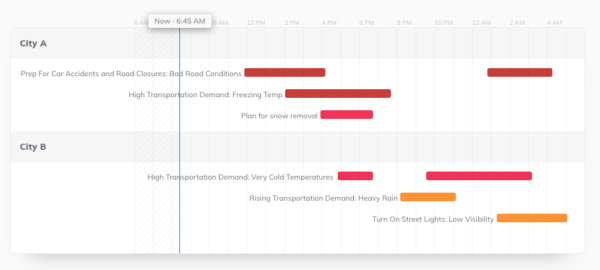After 50 people were killed by flooding from the remnants of Hurricane Ida across the Northeast, New York City Mayor Bill de Blasio said the rise in extreme weather should get everyone “to act very differently.”
With the intensity and frequency of storms on the rise because of climate change, local governments are going to need “entirely different responses, ” de Blasio noted.
However, adapting to climate change on a municipal level to reduce risk and keep communities safe is not always easy or straightforward for local governments.
When record-breaking temperatures hit Western Canada in June, officials faced criticism for failing to communicate the severity of the situation. They sent out a “Level 2: Extreme Heat Alert” in late June, but failed to mention that it was an unprecedented alert.
According to Mark Lysyshyn, Deputy Chief Medical Health Officer for the Health Authority, “People didn’t understand the severity when they issued the extreme heat health alert (in late June) and the difference between that and a warning, as well as its significance.”
As local governments transition from dealing with hurricanes, heat waves, and wildfires in the summer to snow, ice, and floods in the winter, the increasing pace of climate change means it’s more important than ever before to be prepared in advance.
Here’s what every local government should consider for town and city operations when preparing for the coming winter.
Gain Insight to Plan for Winter Operations
While mitigating the impact of climate change at all levels has focused on reducing greenhouse gas emissions, local governments also have a responsibility to help protect property and people from the impact of severe weather happening right now. One of the first steps in preparing for the coming winter is to understand the risks, the potential impact on the community, and the vulnerable sectors and populations.
Data is key if you want to understand how weather events this winter will add to the stresses already facing your system, as well as how effective your methods of assessing and controlling risk are, and potential gaps and vulnerabilities.
Local governments an use weather intelligence to improve operations and respond faster to emergencies at a hyperlocal level. With a weather intelligence platform, you can take your emergency response weather parameters – flood, hail, and lightning risk, icy road conditions, high winds, and more – and create a dashboard like the one below that instantly shows you when the weather forecast is a risk. This approach gives you more time to prepare and adapt to the incoming dangerous weather.

Manage All Local Government Operations
While you might immediately think of snow removal as a clear use case, there are many more ways that weather intelligence can help local governments and municipalities keep citizens safe. Here are some detailed ways that weather intelligence insights can help you prepare for the coming winter:
Improve Harbormaster Communication
Hyperlocal weather forecasts allow harbormasters to make informed decisions that reduce unnecessary damage across port operations. Harbormasters can decide if and when to issue warnings, keep sailboats in harbor secured to a strong pier, or suspend operations.
Prepare for High and Rising Transportation Demand
Weather intelligence gives you insight into when you can expect high public transportation demand due to bad weather conditions, so you can schedule extra staff or perform maintenance in advance.
Protect Equipment
If there is a risk of hail or lightning, you know ahead of time where your most vulnerable and valuable equipment is located. You can send staff to the necessary locations ahead of time and ensure they aren’t at risk.
Plan for Snow Removal
Know in advance when heavy snow is expected. You can then shovel and treat outdoor areas, ensure sidewalks and parking lots are salted and sanded, and get your snowplows ready and operational.
Minimize Risk From Bad Road Conditions
Weather intelligence helps you prepare for car accidents and road closures due to extreme weather conditions and work out when you need to increase emergency response staffing. If visibility is low due to fog or poor air quality, then you know when to turn on street lights.
Send Alerts to Seek Shelter
By monitoring lightning activity, motion, directionality, and speed 15 and 30 minutes into the future based on distance from the location, and receiving cloud to ground alerts, you can alert staff and citizens when they should seek shelter. Setting up these alerts via email, text message, and more streamlines communication across multiple teams and locations and enables you to respond efficiently and quickly to extreme winter weather and adapt to smaller weather events.
Weather Intelligence for Municipalities
Municipalities around the world have already started using weather intelligence to understand how weather impacts city operations. Quincy, Massachusetts was the first city in the U.S. to fully implement a weather intelligence platform, which helps it make better decisions on snow removal.
Due to Quincy’s topography, the weather can change dramatically from one place to another. In order to see insights in different areas of the city, weather intelligence places digital monitors in strategic areas. The city can then better deploy crew and have a more comprehensive understanding of the microclimates ahead of time, whether it’s snowing in one area and raining in another.
Quincy Mayor Thomas Koch explained the value, saying “It can be raining in Hough’s Neck; it could be four inches of snow in the hills of West Quincy. Having the ability to actually identify streets and neighborhoods and give us feedback and information like that, it is really tremendous. It will allow us to be far more efficient with the taxpayer dollars.”
The Tel Aviv Yafo Municipality also uses the Tomorrow.io Insights dashboard at their command center to help them prepare for extreme winter weather. The local authorities get insight into the weather that helps them understand the risk of urban inundations and river flooding.

With a weather intelligence platform, you can get insights that help you plan for local events, like in Quincy and Tel Aviv. This helps you to plan an orderly and optimized response further in advance, which keeps your citizens and staff safe and saves time and money to keep you on budget.
Do You Understand Your Local Weather Risk?
Get a Free Assessment Today.


